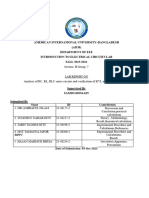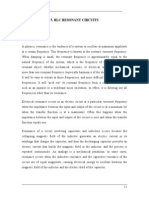LE5 RLC Circuits
Uploaded by
jrcpanganoron00008LE5 RLC Circuits
Uploaded by
jrcpanganoron00008Group Name: _______________________________________ Date: ________________
NATSCI 8 – COLLEGE PHYSICS 2
Laboratory Experiment 5
RLC Circuits
Objectives:
1. To study an RLC circuit with an AC source to create a resonant system.
2. To be familiar with the series RLC Resonance Circuit and its principles.
Materials:
Resistor = 2 kΩ Function Generator
Inductor = 5 mH Oscilloscope
Capacitor = 4.7 μF Multimeter
Procedures:
1. Connect the resistance, capacitance and inductance in series as shown in Figure 1 below.
Figure 1. The Series RLC Circuit
2. Adjust the function generator to 200 Hz, 10 V and 50% duty cycle.
3. Select sine waveform, turn the circuit ON for about 50 ms then turn it OFF.
4. Measure the phase shift between the current I and the input voltage V using oscilloscope.
5. Draw the result of the display graph.
6. Draw the Phasor diagram.
7. Connect the circuit as shown in Figure 2.
Figure 2. Series RLC Circuit for Resonance Analysis
8. Set the voltmeter to 6 Vrms.
9. Select sine waveform; vary the oscillator from 14 kHz to 17 KHz in steps of 0.5 kHz.
10. Record the reading of the voltmeter at each step in the table below.
Frequency (kHz) Irms (A)
(add rows if necessary)
11. Evaluate the impedance of the circuit at each step.
12. Plot a graph of XL, and Xc w.r.t. frequency.
13. Plot a graph of impedance w.r.t. frequency.
14. Determine the value of the impedance at the resonant frequency.
15. Compare the value of the resonant frequency to the theoretical value.
Observations:
1. Can we obtain a plot of XL, against frequency f experimentally?
2. Explain why Phasor and impedance diagrams have the same angles.
3. What is the value of Phasor shift if R = 300Ω; L= 400mH with f = 50Hz. Discuss the
increase or decrease in the phase shift.
4. Comment on the results you have obtained.
Conclusions:
Documentations:
You might also like
- Analysis of RC, RL, RLC Series Circuits and Verification of KVL in RLC Series CircuitNo ratings yetAnalysis of RC, RL, RLC Series Circuits and Verification of KVL in RLC Series Circuit14 pages
- Lab Report 2 RLC Circuits: Abu Dhabi UniversityNo ratings yetLab Report 2 RLC Circuits: Abu Dhabi University7 pages
- Week 4 Lab 1 Series Resonance Lab ReportNo ratings yetWeek 4 Lab 1 Series Resonance Lab Report10 pages
- EXPERIMENT: 5 - Frequency Response and Resonance AimNo ratings yetEXPERIMENT: 5 - Frequency Response and Resonance Aim2 pages
- IEC - EXP - 8 - Analysis of RC, RL, RLC Series Circuits and Verification of KVL in RLC Series Circuit Related To AC Circuit0% (1)IEC - EXP - 8 - Analysis of RC, RL, RLC Series Circuits and Verification of KVL in RLC Series Circuit Related To AC Circuit8 pages
- Ece21.Alcaraz - Experiment 5 - Individual ReportNo ratings yetEce21.Alcaraz - Experiment 5 - Individual Report10 pages
- Electric Circuit Analysis II: Center For Advanced Studies in Engineering, Islamabad Electronics LabNo ratings yetElectric Circuit Analysis II: Center For Advanced Studies in Engineering, Islamabad Electronics Lab14 pages
- NAME: Rosalinda D.C. Conde YR./SEC.: EE-2DNo ratings yetNAME: Rosalinda D.C. Conde YR./SEC.: EE-2D10 pages
- PHY2410L Exp Oscilloscope and AC Circuits Instructions_2No ratings yetPHY2410L Exp Oscilloscope and AC Circuits Instructions_29 pages
- fbfbb22e8df9c515c1d7f3896c5be1f1_experiment8No ratings yetfbfbb22e8df9c515c1d7f3896c5be1f1_experiment812 pages
- Week 4 Lab 1 Series Resonance Lab Report RevisedNo ratings yetWeek 4 Lab 1 Series Resonance Lab Report Revised13 pages
- LC C L X X Also HZ LC: EEET 1003 Electrical Circuit Theory Practical No. 4 Series Resonant Circuit AimNo ratings yetLC C L X X Also HZ LC: EEET 1003 Electrical Circuit Theory Practical No. 4 Series Resonant Circuit Aim3 pages
- Experiment 12: AC Circuits - RLC CircuitNo ratings yetExperiment 12: AC Circuits - RLC Circuit5 pages
- Experiment No. 4-Parallel RC and RL Circuits100% (1)Experiment No. 4-Parallel RC and RL Circuits9 pages
- Parallel RC and RL Circuits Under Ac Excitation Objectives:: Experiment 5No ratings yetParallel RC and RL Circuits Under Ac Excitation Objectives:: Experiment 53 pages
- Experiment 6 Study of Series Resonance by Varying FrequencyNo ratings yetExperiment 6 Study of Series Resonance by Varying Frequency2 pages
- Lab # 5: Study of LCR Resonant Circuit: C D C L R I .No ratings yetLab # 5: Study of LCR Resonant Circuit: C D C L R I .5 pages
- Impedance Spectroscopy: Theory, Experiment, and ApplicationsFrom EverandImpedance Spectroscopy: Theory, Experiment, and ApplicationsEvgenij BarsoukovNo ratings yet



























































